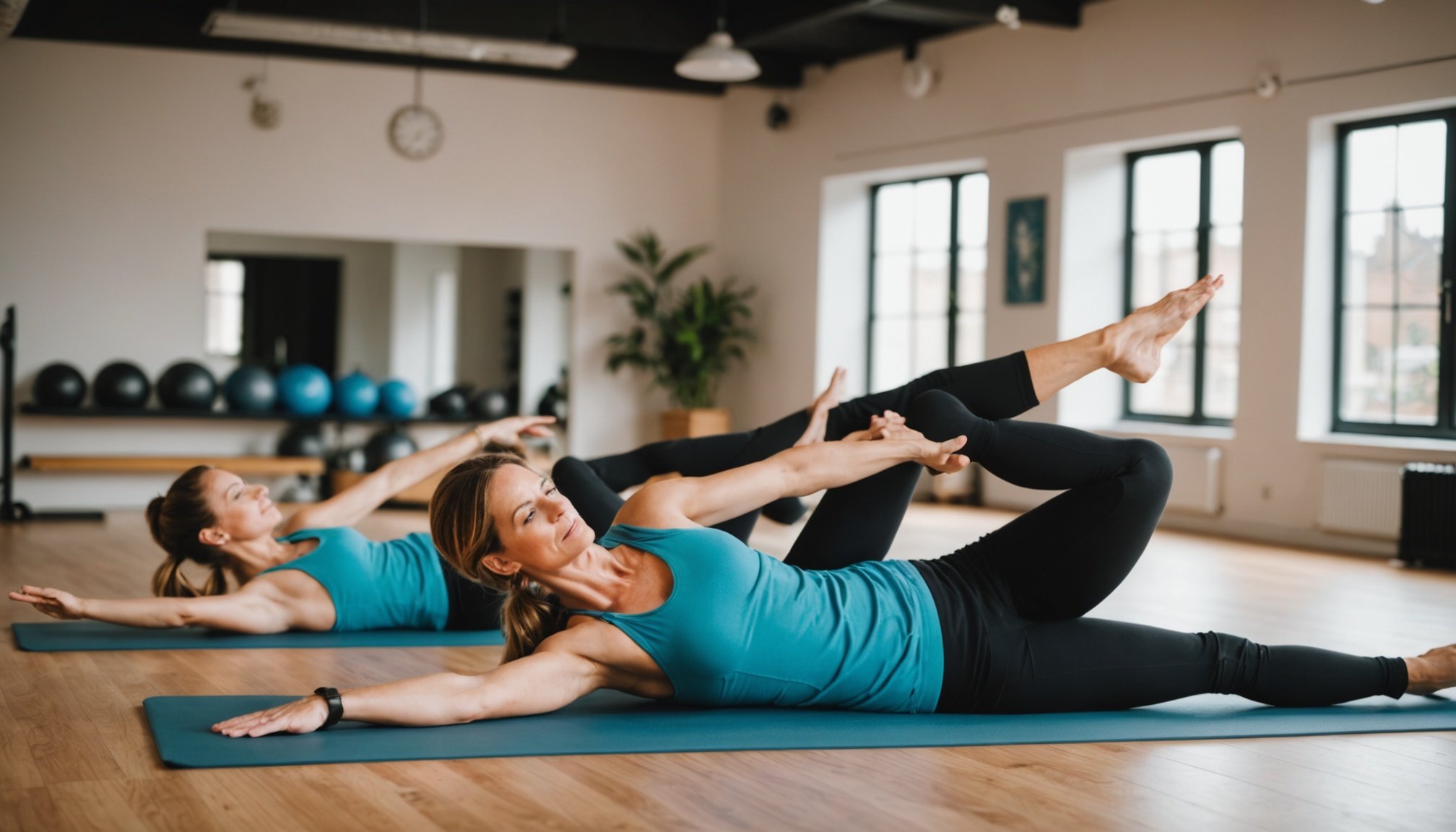Unlocking Wellness: The Surprising Advantages of Pilates for Women in Their 30s Across the UK
Why Pilates is a Game-Changer for Women in Their 30s
As women navigate their 30s, they often face a myriad of challenges that can impact their physical and mental health. From career pressures and family responsibilities to the natural changes that come with aging, it’s easy to neglect one’s own wellbeing. However, incorporating Pilates into their fitness routine can be a transformative decision, offering a wide range of benefits that extend far beyond the physical.
Physical Health Benefits
Pilates is renowned for its ability to improve core strength, flexibility, and overall body alignment. Here are some key physical health benefits that make Pilates an excellent choice for women in this age group:
Additional reading : Ultimate Guide for UK Residents: Transform Your Sleep Space for Improved Rest and Relaxation
-
Core Strength: Pilates focuses heavily on building core strength, which is essential for maintaining good posture, reducing back pain, and enhancing overall stability. A strong core also supports the pelvic floor, which is particularly important for women, especially those who have had children or are experiencing menopausal changes[2].
-
Flexibility and Mobility: As we age, our flexibility and mobility can decrease. Pilates helps maintain and even improve these aspects through a series of controlled movements that stretch and strengthen the muscles without putting excessive strain on the joints.
In parallel : Unlocking Flexibility: How Consistent Pilates Can Benefit Seniors in the UK
-
Body Alignment: Proper body alignment is crucial for preventing injuries and reducing chronic pain. Pilates teaches women how to move with precision and control, ensuring that their bodies are aligned correctly during each exercise.
Mental Health and Wellbeing
The benefits of Pilates are not limited to the physical; it also has a profound impact on mental health and wellbeing.
-
Stress Reduction: Pilates combines physical movement with deep breathing techniques, which can help reduce stress and anxiety. This mind-body connection is particularly beneficial for women who often juggle multiple responsibilities and may feel overwhelmed.
-
Improved Mood: Regular Pilates practice can release endorphins, also known as “feel-good” hormones, which can help alleviate symptoms of depression and improve overall mood.
-
Better Sleep: By reducing stress and improving physical comfort, Pilates can help women achieve better sleep quality, which is essential for both physical and mental health.
Types of Pilates Classes Suitable for Women in Their 30s
There are several types of Pilates classes that women in their 30s can benefit from, each offering unique advantages.
Mat Pilates
- Accessibility: Mat Pilates is the most accessible form of Pilates, requiring no special equipment other than a mat. This makes it easy to practice at home, in a studio, or even in leisure centres across the UK.
- Cost-Effective: Without the need for expensive equipment, mat Pilates is a cost-effective way to start or continue a Pilates journey.
- Versatility: Mat Pilates classes can be tailored to various fitness levels, making it suitable for both beginners and advanced practitioners.
Reformer Pilates
- Equipment-Based: The reformer is a specialized piece of equipment that uses springs and a moving carriage to provide resistance. This can be particularly beneficial for building strength and improving flexibility.
- Targeted Workouts: Reformer Pilates allows for more targeted workouts, especially for the core and upper body.
- Low-Impact: Despite its effectiveness, reformer Pilates is a low-impact exercise, making it ideal for women who need to avoid high-impact activities due to joint issues or other health concerns.
Wall Pilates
- Support and Stability: Wall Pilates uses the wall for support and stability, which can be especially helpful for women who are new to Pilates or need additional support.
- Core Focus: Wall Pilates often focuses on core exercises, which are crucial for overall body stability and strength.
- Space-Efficient: This type of Pilates can be practiced in smaller spaces, making it a great option for home workouts.
How to Get Started with Pilates
Getting started with Pilates is easier than you might think, and here are some steps to help you on your journey:
Finding the Right Class
- Local Studios: Look for local Pilates studios or leisure centres in your area that offer classes. Many studios offer trial classes or introductory packages.
- Online Classes: If you prefer the convenience of home workouts, consider online Pilates classes. Many instructors offer virtual sessions that you can join from anywhere.
- Community Centers: Community centers and gyms often include Pilates in their group fitness schedules.
Choosing the Right Instructor
- Qualifications: Ensure that your instructor is certified in Pilates. Look for certifications from reputable organizations.
- Experience: Opt for an instructor who has experience teaching women in their 30s. They will be better equipped to address specific needs and concerns.
- Reviews and Testimonials: Check reviews and testimonials from other clients to get an idea of the instructor’s teaching style and effectiveness.
Preparing for Your First Class
- Comfortable Clothing: Wear comfortable, stretchy clothing that allows for a full range of motion.
- Mat and Equipment: If you’re attending a mat class, bring a good-quality yoga mat. For reformer or wall Pilates, the equipment will be provided.
- Hydration: Stay hydrated by bringing a water bottle to class.
Practical Tips and Advice
Here are some practical tips and advice to help you make the most out of your Pilates journey:
Start Slow and Be Consistent
- Begin with Basics: Start with beginner classes or sessions to get a feel for the movements and breathing techniques.
- Regular Practice: Aim to practice Pilates at least 2-3 times a week for consistent benefits.
Listen to Your Body
- Rest When Needed: Don’t push yourself too hard. If you feel pain or discomfort, rest and modify the exercises as needed.
- Modify Exercises: Many Pilates exercises can be modified to suit different fitness levels. Don’t hesitate to ask your instructor for modifications.
Combine with Other Activities
- Yoga and Pilates: Combining Pilates with yoga can enhance your overall fitness and wellbeing. Both practices complement each other well, focusing on different aspects of mind-body connection[1][2].
- Outdoor Activities: Incorporate outdoor activities like walking or cycling to add variety to your fitness routine.
Real-Life Examples and Success Stories
Many women have found significant improvements in their health and wellbeing through Pilates. Here are a few examples:
Noémie Tinkler’s Journey
Noémie Tinkler, a Pilates instructor, discovered the transformative power of Pilates after a period of personal struggle. She found that Pilates not only improved her physical health but also provided a sense of inner peace and connection to her body. Noémie now teaches Pilates, helping other women achieve similar benefits[2].
Angela Boismenu’s Story
Angela Boismenu, another instructor, began her yoga and Pilates journey after a spinal injury. Through consistent practice, she was able to manage her chronic pain and improve her overall health. Angela’s story highlights the therapeutic benefits of Pilates and how it can be adapted to meet individual needs[2].
Pilates is more than just an exercise routine; it’s a holistic approach to health and wellbeing that can significantly benefit women in their 30s. Whether you’re looking to improve your physical strength, reduce stress, or enhance your mental health, Pilates offers a comprehensive solution.
Key Takeaways
- Physical Benefits: Improved core strength, flexibility, and body alignment.
- Mental Health: Stress reduction, improved mood, and better sleep quality.
- Accessibility: Various types of classes (mat, reformer, wall) available in studios, leisure centres, and online.
- Practical Tips: Start slow, be consistent, listen to your body, and combine with other activities.
By incorporating Pilates into your fitness journey, you can unlock a new level of wellness that will benefit you in countless ways. So why not give it a try? Book a class today and start your path towards a healthier, happier you.
Detailed Bullet Point List: Benefits of Pilates for Women in Their 30s
-
Core Strength:
-
Improves posture
-
Reduces back pain
-
Supports pelvic floor health
-
Enhances overall stability
-
Flexibility and Mobility:
-
Maintains and improves flexibility
-
Enhances mobility without excessive strain on joints
-
Helps in preventing injuries
-
Body Alignment:
-
Teaches proper body alignment
-
Reduces chronic pain
-
Prevents injuries
-
Stress Reduction:
-
Combines physical movement with deep breathing techniques
-
Releases endorphins
-
Improves mood
-
Better Sleep:
-
Reduces stress
-
Improves physical comfort
-
Enhances sleep quality
-
Mind-Body Connection:
-
Enhances mental health
-
Provides a sense of inner peace
-
Improves overall wellbeing
Comprehensive Table: Types of Pilates Classes
| Type of Pilates | Description | Benefits | Equipment Needed |
|---|---|---|---|
| Mat Pilates | Practices on a mat without equipment | Cost-effective, versatile, accessible | Mat |
| Reformer Pilates | Uses a reformer machine for resistance | Targeted workouts, low-impact, builds strength | Reformer machine |
| Wall Pilates | Uses the wall for support and stability | Core focus, space-efficient, supportive | Wall |
Quotes from Experts
-
“Pilates is a journey of discovery, passion, and transformation. It helps in connecting with oneself through physical practice and aspires to transmit compassion and understanding through teaching,” – Lita, Pilates Instructor[1].
-
“Pilates gives you the tools to manage pain rather than relying on medication. It’s a daily practice that has helped me in my own journey towards sobriety and better health,” – Angela Boismenu, Pilates Instructor[2].
-
“Pilates creates an environment where you feel free to listen to your body, recentre, and be fully yourself. It’s about aligning the body, mind, and heart,” – Pauline Roussel, Pilates Instructor[2].











